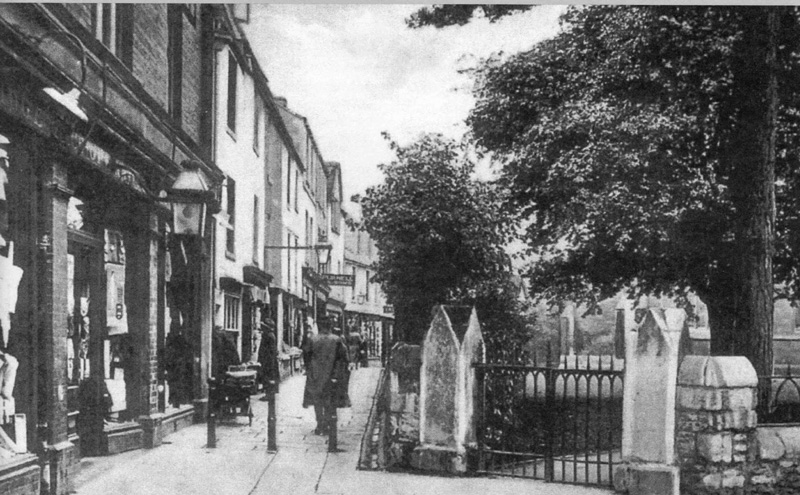 |
Church Street in the 30s |
Contents
Click on the item to go to the article. |
Editorial Comment
The offending publication referred to by the Chairman received a withering response from our President. In his letter published in the Wilshire Times on 2nd May. He was further supported a week later by a correspondent from Bradford-on-Avon. The Society can be very encouraged with much of the recent regeneration as highlighted in Ken Rogers’ piece and Margaret Howard's upbeat report of what is in the pipe line. You may contact us on 760139 or 46 St Thomas’s Road or email: johnkay.austin®homecall.co.uk
The deadline for copy for the next edition is |
Forthcoming Events
| Saturday 28th June 10:00 – 16:00 |
Community Spotlight 2008 (volunteers needed – contact Celia Russell) |
Trowbridge Park |
| Wednesday 23rd July 19:00 |
Guided Walk around Box, led by Chris Ward | Meet at Selwyn Hall, Box (SN13 8NT) |
| Saturday 16th August 10:30 – 12:00 (noon) |
Bring and Buy (Cake Stall, Bric–a–brac etc.) Proceeds to be shared with the Hope Centre. |
Hope Centre, Southwick Country Park |
| Wednesday 20th August | Visit by coach to Tyntesfield House | Please click here for more detail about the trip. For more details about Tyntesfield, click here. |
| Monday 1st September 19:00 |
Guided Walk around Freshford, led by Dr. Alan Dodge | Meet at St. Peter's Church, Freshford |
| Saturday 13th September 10:00 – 16:00 |
Heritage Open Day (various local sites open) | See the Open Day web page or local press |
| Tuesday 14th October 19:30 |
Talk on Isambard Kingdom Brunel, by Mr. John Salvat | Mary Ragbourne Hall, Courtfield House, Polebarn Road, Trowbridge. |
From the President
In 1985 the organisation, Save Britain’s Heritage produced a report called Trowbridge, the Fastest Disappearing Mill Town in the West! which described it as the Cinderella of West Country towns. The writer fully appreciated the town's heritage – ‘it is a town of many splendid buildings’ – and laid special emphasis on its industrial past. But she also put the blame implicit in her title on the town – ‘It is curious that Trowbridge has taken so little interest in its past’. She drew contrasts between active conservation policies pursued, for instance, at Bath (hardly fair, I think) and Bradford-on-Avon, and Trowbridge, ‘which lags far behind’.
The report then highlighted a number of ‘neglected sites’. These began with the former George Hotel, which had just been dismantled and, the writer thought, hopelessly ruined. In fact, the original facade was put back up, a successful piece of urban conservation. The Victoria Technical Institute, demolished in 1984, comes next. As she says, it did not endear itself to Trowbridge residents (I certainly always disliked it), and, as she does not say, its internal arrangement made it very difficult to use for any other purpose. I agree wholeheartedly with her comment on what replaced it as undistinguished and underscaled, and equally with her condemnation of two modern buildings, the Post Office and Boots.
The former McCalls' factory site, at present occupied by Mount Crushmore, went in 1980. At the time I could see no future for this higgledy–piggledy and rather run–down group of buildings, and they were not of quite such historical interest as, say, those in Court Street. Thirty years on, in a different climate, I think parts would have been saveable.
The Save writer spoke approvingly of the restoration of Studley Mill, and hoped that the power loom shed (on the site of the ASDA car park) might be saved by conversion to a supermarket; I find it hard to imagine this as possible. She mentioned the impending loss of York Buildings and adjoining houses in Timbrell Street for the then proposed inner relief road, and commented on the run–down state of the Halve. Finally she came to the deplorable and inexcusable demolition of the railway station and goods shed in 1984.
How have we done since then? I have wracked my brains, and find it difficult to think of any historic buildings of major importance lost since 1985, with one exception; this is the Conigre Unitarian Church of 1857, demolished in 1988 after being derelict for some years. Parts of Studley Mill and Home Mill are perhaps regrettable losses, but their demolition did enable the town to aquire a shopping facility right in the centre without serious damage, and I think that The Shires has been a great asset to the town. Another loss, unnecessary and against widely expressed opposition, was the handsome 1926 Police Station. We are about to lose what is left of the old foundry (opposite the entrance to the Shires car park), and the Ushers Club, formerly the County Council’s first offices.
On the credit side, the establishment of conservation areas has meant that the range of buildings in the town centre, from the medieval through Georgian to the imposing Victorian commercial and municipal examples, are almost all in regular and profitable use and well cared for. And we can list a number of restoration projects, such as the handle house, the Conigre Parsonage and Westcroft, old St. James's Hall, the late medieval house and the old Co–op shop in Church Street, and (one I find particularly pleasing), the whole of the west side of Hill Street including the buildings behind. The Save writer would be pleased to see the change for the better in the Halve.
Unseemly gaps have disfigured our town centre for too long, so we can applaud their abolition in the Conigre and Duke Street. There is more to be done here – Church Street, Union Street, and Castle Street all come to mind.
Finally, I hope that no–one could now say that Trowbridge takes little interest in its past. The setting up of our excellent Museum speaks for itself, and no other local town has had so much work on its history published in the last twenty five years. Bradford-on-Avon, held up to us in 1985 as an example of a town interested in its past, is still without any adequate history.
Farewell to Margaret Stancomb School
Margaret Stancomb School was built in 1893 as the Margaret Stancomb Memorial Infant School and was founded by John Perkins Stancomb in memory of his late wife. In his will of 1895 he named the following trustees, Sir William Roger Brown, John Frederick Stancomb, William John Mann, Jacob Usher, William Nelson Haden, Richard Henry Sainsbury and Isaac Chapman. Most of us are still familiar with the names of these local worthies. The school was designed for a maximum of 139 children and was opened on 23rd February 1894 by J F Stancomb. The school was non–denominational and was transferred to Wiltshire County Council in 1908. 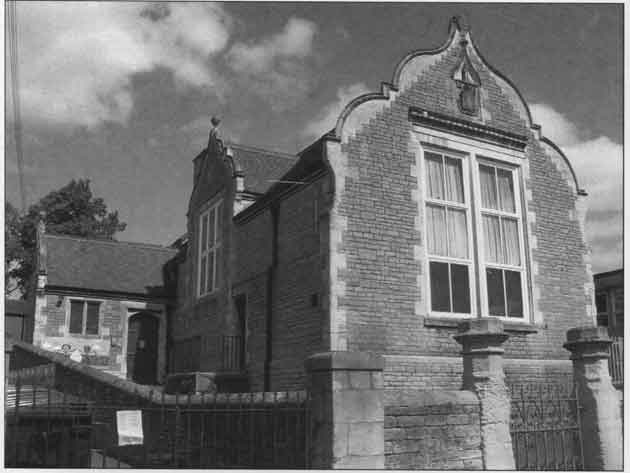 The first head mistress was Leah Home who was assisted by three pupil–teachers and an assistant mistress. She left in 1922 to be succeeded by Miss Margaret Collier. In 1932 the school expanded with the addition of a new building. The enlargement was due to the amalgamation with St Thomas’s Infant School and the Parochial Infant School and the attendance rose to 198 with seven classes and five teachers assisting Miss Collier. I recently spoke to 101 year old Mrs Edith Maidment who taught at the School from 1949-1970. Edith originally came to Trowbridge in 1927 at the age of 20 to teach at the Adcroft Girls School. The pupils there were aged 10-14. It stood next to Margaret Stancomb School and was a large stone built building with stone floors and iron banisters – looking more like a factory than a school. She taught there until 1934, when she left to start her family. In 1949 she was asked to return to teaching at Margaret Stancomb School – on supply – and stayed for 21 years.
The first head mistress was Leah Home who was assisted by three pupil–teachers and an assistant mistress. She left in 1922 to be succeeded by Miss Margaret Collier. In 1932 the school expanded with the addition of a new building. The enlargement was due to the amalgamation with St Thomas’s Infant School and the Parochial Infant School and the attendance rose to 198 with seven classes and five teachers assisting Miss Collier. I recently spoke to 101 year old Mrs Edith Maidment who taught at the School from 1949-1970. Edith originally came to Trowbridge in 1927 at the age of 20 to teach at the Adcroft Girls School. The pupils there were aged 10-14. It stood next to Margaret Stancomb School and was a large stone built building with stone floors and iron banisters – looking more like a factory than a school. She taught there until 1934, when she left to start her family. In 1949 she was asked to return to teaching at Margaret Stancomb School – on supply – and stayed for 21 years.
Her first class was of 42 four year olds, very different from her previous experience with secondary girls! Mrs Williams who taught the youngest class had 40 three year olds - but did have the help of a teaching assistant. The children sat at desks in twos and before they were allowed pencils they used small individual blackboards and chalk. They learned to read phonetically, to write and to do their sums. Singing lessons were held in the old building where the head teacher held her class. School inspections occurred on a random basis, the inspectors sitting in on lessons to watch the teachers perform with no prior warning. The children were regularly weighed and measured and examined by the ‘nit nurse’. Break times were always spent outside, Miss Collier herself having painted a white line across the playground to separate the under fives from the older children.
There were no uniforms, no cars bringing children to and from school and almost all the children and teachers went home to lunch, after returning from lunch the children in the first two Classes had to lie down and rest for 45 minutes; Mrs Williams’ class on little wooden trestle beds and Edith’s class on oval rush mats. The new classrooms opened onto a veranda and the large doors ensured that one side of the room could be totally open. Assemblies were held daily – the three and four year olds together and the five to seven year olds holding theirs in the old building. The children went to The Tabernacle Church (now United Reform Church) for harvest festivals and carol services. In 1953 the children joined all the other schools of the town to watch the film of the coronation at the Gaumont cinema.
The head teacher was allowed to use a punishment cane on the legs of offenders, but more often a slap was delivered. Many of the children came from large families and Edith recalls when a member of such a family was kept behind for a misdemeanour, his mother marched up to the school and pronounced: If it weren’t for the likes of us breedin’ ‘em – you wouldn’t have a job teachin’ ‘em.
Edith retired in 1970 by which time she was deputy headteacher and teaching the 6–7 year olds. By the time the children moved on to junior school they could read and write and knew their tables.
Jean Johnson enrolled in the school in the early 1930's. The Headmistress, Miss Collier, once gave her a smack when Jean pointed out that her name had been spelt incorrectly, however this did not deter Jean, who later attended college and returned to the school in 1951 as the reception teacher – with Miss Collier still the head mistress. Miss Collier retired the following year, the new head was Miss Howard who became 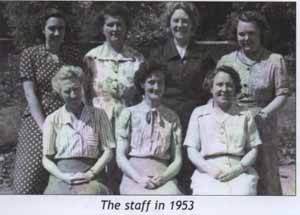 Mrs Soul and after the untimely death of her husband, Mrs Swanborough.
Mrs Soul and after the untimely death of her husband, Mrs Swanborough.
Jean, who soon became Mrs Foggett, had over 40 children in reception and no helpers. At dinner time the desks had to be stacked away to make space for the afternoon activities. She recalls one pupil leaving the washbasin taps on and when she unlocked the classroom after lunch, water poured out in a flood. No help, so another job for the teacher to sort out. There were many changes to the building, the verandas were enclosed and the doors to the classrooms removed. This created an open plan walkway alongside the classrooms which became very noisy, especially for Jean who had the first classroom and every class had to pass by. The little desks were replaced by octagonal tables which the children sat round resulting in some children unable to see the blackboards so these too were removed. Jean felt the children loved their little desks and were quiet and well behaved when sitting more formally.
When the Adcroft Girls School was being demolished, Jean’s classroom was a mobile on the site and when a major wall had to come down, Mr Hillier Brown would come in and shout: “vacate!” and Jean had to rush the children into the main hall until the danger had passed and they could safely return. In 1960 Jean left to start her family and in 1962 was approached to return on supply, to work for a fortnight – afternoons only, she eventually left in 1986!
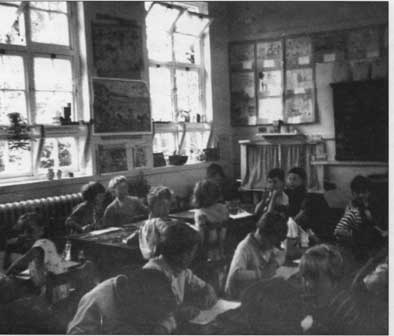 In the 1960’s and 70’s two classes were held at the Tabernacle Church as the school was too small to hold all the children. Playtime was held in the front of the church unless, of course, there was a funeral or a wedding. Each lunchtime Jean, who by now had a class helper, would take the children in a crocodile to Margaret Stancomb for lunch and then back for afternoon classes. By this time most children stayed to school lunch, which was brought in from a central kitchen in Devizes. On one occasion the van could not get through due to snow, so Mrs Swanborough went to town and bought cheese and crackers etc. and made sure the children had a lunch. Often the pupils would ask if they could play on the ‘hossie’. At first Jean had no idea what they meant, but it was soon clear that wanted to play on field belonging to Trowbridge Hospital, which was where sports day was held.
In the 1960’s and 70’s two classes were held at the Tabernacle Church as the school was too small to hold all the children. Playtime was held in the front of the church unless, of course, there was a funeral or a wedding. Each lunchtime Jean, who by now had a class helper, would take the children in a crocodile to Margaret Stancomb for lunch and then back for afternoon classes. By this time most children stayed to school lunch, which was brought in from a central kitchen in Devizes. On one occasion the van could not get through due to snow, so Mrs Swanborough went to town and bought cheese and crackers etc. and made sure the children had a lunch. Often the pupils would ask if they could play on the ‘hossie’. At first Jean had no idea what they meant, but it was soon clear that wanted to play on field belonging to Trowbridge Hospital, which was where sports day was held.
On 31st of December 2007 there were 82 infants and 25 nursery children on the school roll with a staff of 22. On the first of January 2008 Margaret Stancomb Infant School amalgamated with the Parochial Junior School to become the Bellefield Primary School. The name was chosen by the pupils and reflects the area of the town in which the school is situated. A new building is in the process of being erected for the younger children at the site on Windemere Road. At present, the Margaret Stancomb site is still being used, the new building should be completed later this year and from the first of January 2009 all the children will be taught on one site.
My to thanks Mrs Edith Maidment and Mrs Jean Foggett for their many memories – only a few of which are recalled here.
Planning Matters
It has been a very quiet time since the Spring Newsletter for planning applications and decisions in the Trowbridge Community Area.
Bellefield House has been badly treated by previous 20th century owners. The current owners appear to appreciate the Grade II Listed Building status, and have treated the side walls with sandstone masonry paint, which has certainly improved the appearance.
Islington Motors have moved from Bradford Road to a new site on Canal Road. We looked at the plans for the redevelopment of the Cockhill site, and thought that they were appropriate for that area. The 14 three bed room town houses and 6 two bed room flats are partly terraced and have an interesting roof line, with chimney pots, and are set back on a service road. The gardens vary in length, because of the shape of the plot. A report shows that there is virtually no flood risk – just once in a millennium.
Although Lloyds Bank want to hang a new advertising sign on their superb Grade I Listed Building it is to be fitted into the existing bracket so the building itself will not suffer in any way.
West Wiltshire District Council has applied to use land to the east of Innox Road as a temporary car park while places elsewhere in the town are out of use.
In February we looked at the Parkridge Developments and Waitrose joint application for the former Peter Black site on County Way. Whilst we wish to see this derelict site redeveloped as soon as possible, we had severe reservations about public transport access to and egress from the site. These issues are being addressed by the County Council Highways Department. The proposal for the former Ushers bottling plant site also includes a supermarket. Barton Finch, site owners, have teamed up with Sainsburys. Planning Officers and Councillors have to decide whether these proposals are in conflict and weigh up the relative benefits each would bring to help achieve the goals in Transforming Trowbridge. Parkridge Developments also own the former Wincanton site and have been authorised to start demolition as they are ready to start work on Shires Gateway.
After receiving approval, work was quick to start on the retail units and flats at the junction of Duke Street and Church Street. Plans submitted in September 2006 for a 3-storey development of 31 apartments on the lower part of the Broad Street car park were approved in February 2008.
Enhancement of the River Biss as it flows through the town is a critical issue in Transforming Trowbridge. We are currently awaiting recommendations from Halcrow, the firm appointed to survey the area and consult with interested bodies and the general public. Some of you saw their display either in the Civic Hall or the library. John Austin, having recently rewritten our Nature Trail leaflet, has up to date knowledge of this richly biodiverse habitat. As an interested individual he wrote to Adam Nardell, the Regeneration Projects Manager at WWDC, expressing general enthusiasm for the proposals but voicing two concerns. He thought that the proposed angling lake was too small and would spoil a flower, butterfly and dragonfly rich part of the Biss Meadows Country Park. Apparently that idea had already been shelved precisely because of the biodiversity value of that area. John was also concerned that the urban river bank changes may lose those quiet refuge areas used by kingfishers and grey (i.e. bright yellow) wagtails, such a joy to see regularly in the centre of the town. Adam’s reply was very positive on this and as he has worked as a conservationist with the RSPB, The National Trust and Wildlife Trusts we can be fairly certain that his sympathies accord with those of wildlife enthusiasts like John and several others among our membership.
The Wiltshire Primary Care Trust, at its Board Meeting in May, will be looking at the Business Plan for the Trowbridge Primary Care Centre. If you wish to be informed about this critically important issue which is central to the future of health services for the Trowbridge Community Area, watch the local press and, if you have access to their website – http://www.wiltshirepct.nhs.uk/, look at the Board’s papers.
Evidence of our Military Past
Within the town the obvious features include the war memorial, fragments of the barracks boundary wall in Frome Road and Bradley Road and the remains of the anti–blast tape on Aplin’s window in Park Road. Should we include Haden’s old works which were given over to significant war work during both major conflicts? In the surrounding villages there are rather more relics. On the canal beyond Hilperton there are a couple of pillboxes (one a Type 22) 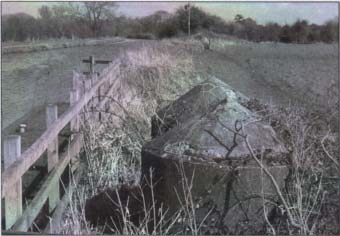 and two sets of large concrete bollards (“tank traps”). The Barnes steamroller buildings at Southwick (latterly Mowlem and now the site of proposed redevelopment), were used for the assembly of Spitfire parts – but not purpose built and maybe should be excluded. At West Ashton, the line of small ponds in Green Lane Wood is said to mark the craters caused by a stick of German bombs. Nearby the hard standing on the south side of the A350, where formerly there was a hanger, is said to have been a standby emergency aerodrome – with the road being long and wide enough to have been used as a runway! Does anyone know the location of the American “Club Strip” runway at Trowbridge? My own WW2 memories are fragmentary but quite vivid is my recollection of enjoying a mug of cocoa with “my” American tank crew, just over our back fence in Bradley Road, and being whisked off to an urgent muster in the centre of the field – the one with the rifle range. Here I was certainly, but uncomprehendingly, a party to a briefing on the very imminent Normandy landings. I was told “to get down Johnny” by my friends and luckily for them was undiscovered by the men with maps and pointers.
I am interested in creating a longer article, or even a pamphlet, on our military relics but need collaboration with readers who almost certainly know of much more than those items referred to above. As far as I know, none of the purpose built structures (except the war memorial) has any guarantee of preservation and it would be scholarly, and fun, to make an illustrated record.
and two sets of large concrete bollards (“tank traps”). The Barnes steamroller buildings at Southwick (latterly Mowlem and now the site of proposed redevelopment), were used for the assembly of Spitfire parts – but not purpose built and maybe should be excluded. At West Ashton, the line of small ponds in Green Lane Wood is said to mark the craters caused by a stick of German bombs. Nearby the hard standing on the south side of the A350, where formerly there was a hanger, is said to have been a standby emergency aerodrome – with the road being long and wide enough to have been used as a runway! Does anyone know the location of the American “Club Strip” runway at Trowbridge? My own WW2 memories are fragmentary but quite vivid is my recollection of enjoying a mug of cocoa with “my” American tank crew, just over our back fence in Bradley Road, and being whisked off to an urgent muster in the centre of the field – the one with the rifle range. Here I was certainly, but uncomprehendingly, a party to a briefing on the very imminent Normandy landings. I was told “to get down Johnny” by my friends and luckily for them was undiscovered by the men with maps and pointers.
I am interested in creating a longer article, or even a pamphlet, on our military relics but need collaboration with readers who almost certainly know of much more than those items referred to above. As far as I know, none of the purpose built structures (except the war memorial) has any guarantee of preservation and it would be scholarly, and fun, to make an illustrated record.
Twenty Golden Candlestick Revisited
 This new publication by Andrew D Jones contrasts the fortunes of 26 Baptist chapels in 2005 and 1890, when William Doel published the original book. With the possible sale of Trowbridge’s United Church and Emmanuel Chapel in mind, it is no surprise to find Andrew’s comparison stark. Nine of the chapels have been sold, one has changed denomination and the remaining sixteen are generally hugely reduced in membership. Nevertheless, as all those who attended the book launch at Zion Chapel on Thursday 13th March can attest, our current Baptists are full of energy and enthusiasm. My signed copy sits nicely next to my battered original which was given to me by one of my old teachers, the late Bessie Rodway.
This new publication by Andrew D Jones contrasts the fortunes of 26 Baptist chapels in 2005 and 1890, when William Doel published the original book. With the possible sale of Trowbridge’s United Church and Emmanuel Chapel in mind, it is no surprise to find Andrew’s comparison stark. Nine of the chapels have been sold, one has changed denomination and the remaining sixteen are generally hugely reduced in membership. Nevertheless, as all those who attended the book launch at Zion Chapel on Thursday 13th March can attest, our current Baptists are full of energy and enthusiasm. My signed copy sits nicely next to my battered original which was given to me by one of my old teachers, the late Bessie Rodway.
Andrew's well produced book is available at £6.50 from the Museum shop or by sending a cheque (£6.50 plus 50p p&p) to Andrew Jones at 45 Innox Road, Trowbridge, BA14 9AT.
Horse Road 50 years ago
It is 50 years since my late husband and I rented a small cottage, 9 Horse Road. I had lived in Bath and always yearned to live in the country. The cottage, one of a small terrace owned by Linzey the builders, was nicknamed White City by the locals. The rent was 15/- a week reduced to 14/10 when the rates for 1960 were lowered by the Bradford Rural District Council!
The cottage had been lived in by a couple who were moving near their children and we started to decorate it in October 1958 before we were married in March 1959. We cycled out from Harford Street where Brian’s mother lived and had to turn back on several occasions because the fog was too thick as we approached ‘the marsh’.
The cottage was in a bad state of repair and when we pulled up the lino in the living room we found several layers of damp lino on top of uneven flagstones so they were taken out by the owners and a concrete floor put in. Of course the coal had been stored in the cupboard by the fireplace so that had to be cleaned, scrubbed and painted.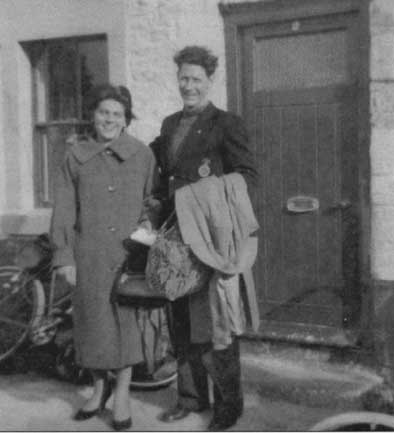 There was no bathroom only a toilet across the yard but ours was superior to the others as we had electric light. For a bath we filled the washing machine once a week and pumped out the heated water into a tin bath in the kitchen. Outside was a small yard at the back and a long front garden which went to the hedge on Horse Road. Behind us were fields farmed by Mr. Pike of Pound Farm and in front of us were fields stretching through to Marsh Road. Most of the houses on the south side of Horse Road were only approached from unadopted lanes leading off the road. I can only remember one actually on the road and that was Pear Tree Cottage near the Hilperton end. On the northern side of the road there was the ‘Tin Church’, St. Mary’s and a few bungalows towards Trowbridge then two or three fields before a pair of semi-detached redbrick houses and at the far end on the corner a few stone cottages.
There was no bathroom only a toilet across the yard but ours was superior to the others as we had electric light. For a bath we filled the washing machine once a week and pumped out the heated water into a tin bath in the kitchen. Outside was a small yard at the back and a long front garden which went to the hedge on Horse Road. Behind us were fields farmed by Mr. Pike of Pound Farm and in front of us were fields stretching through to Marsh Road. Most of the houses on the south side of Horse Road were only approached from unadopted lanes leading off the road. I can only remember one actually on the road and that was Pear Tree Cottage near the Hilperton end. On the northern side of the road there was the ‘Tin Church’, St. Mary’s and a few bungalows towards Trowbridge then two or three fields before a pair of semi-detached redbrick houses and at the far end on the corner a few stone cottages.
I was content as we lived in the country with several tall elm trees in the hedgerows on Mr. Pike’s land and hares running that we startled as we rounded a hedge when we walked the dog. Mushrooms were plentiful in the autumn. Access to the fields was by several footpaths accessed via the lanes. One lane had a thatched cottage with outbuildings and hens running free in the fields. The fields to the north were full of skylark song from spring through summer, cuckoo were heard every year, barn owls and tawny owls called at night and bats were seen flying at dusk.
One or two characters I remember very clearly. Near us lived Mr. and Mrs Ernie Alder. Ernie was the road sweeper for the Victoria Road area of the town and was said to do well for tips at Christmas. He was a small man who kept his garden and tools in immaculate condition always cleaning them and sharpening his spade after use. Apart from a few flowers near the cottage, vegetables were grown in allotment–like rows. I wonder if he had been a gardener in a large house before he moved to Hilperton Marsh. Other characters I noticed were 3 men who walked to the Prince of Wales pub on Wyke Road. All three were slim and the trio were led by an upright man followed by one slightly bent and the third, with a stick and very bent. They always walked in this formation and I later found out they were two brothers and their nephew.
The neighbours were very friendly and helpful giving advice about gardening, picking in washing and always ready for a chat. The gardens were open plan with no fences in the front only the back yards had a fence between them. On bonfire night we all met behind Pound Cottage, which was not enclosed then, all bringing a little food and fireworks to set off by the bonfire we had built. Each lane seemed a small community in itself and it is still the same today. There are at least 5 lanes on the south side of Horse Road. They are still unmade, muddy and full of potholes and puddles in winter and very dusty in summer. The only cottage that has disappeared is Pear Tree Cottage. We spent a year in this cottage before moving further towards the Hilperton end of the road in March 1960. From that time on all was to change.
Reminiscences of Church Walk
Society members will no doubt recall the newsletter item some time ago, in which Jessie Whitmarsh described her school days at the Miss Minty’s school in Clark’s Place. Miss Whitmarsh’s family owned premises in Church Walk, where her grandfather had a jewellery business. After his death her father moved his shoe shop from Fore Street into Church Walk and Jessie moved there when she was two years old and she lived there until shortly after her father’s death in 1960.
She recalls the shops in Church Walk from Church Street, the first being the Co–op furniture shop, here the door was always open but with, it seemed, no one in attendance – one had to walk in and wander about until you found someone to help – an unusual situation in those days. Next door was Davis’s fish and fruit shop, which was run by Dan Brown. The shop was open fronted and bitterly cold in the winter. When Mrs Brown helped out she wore a fur coat.
At number 3 was Jenkins the newsagents who also sold tobacco and toys, followed by two sweet shops. The first was run by two sisters – the Miss Whites. They made their own sweets including huge peppermint humbugs, these were Jessie’s favourite and cost a halfpenny each and were a great treat. Besides sweets they sold some vegetables and odds and ends. The second sweet shop was Brays, as well as sweets they sold toys.
At number 6 was another shop owned by the Jenkins family. This shop sold virtually the same range of goods as those at number 3. This later became the shop for Modelux. Next door was a shoe shop “Jefferies” but run by the manager, then at number 8 came Purnell and Sons run by Howard Purnell, bespoke tailors. It was here that Mr Whitmarsh had his suits made. The suits were made upstairs in a workroom in which 2 or 3 ladies did the sewing. Mr Whitmarsh, whose shop was next door was pleased not to have to go too far for his fittings.
After the Whitmarsh shop was the newsagents, which many members will remember. It was from here that many paperboys collected their paper rounds early in the morning. The boys congregated in Church Walk and were very noisy and boisterous and often Jessie was woken at an early hour by the shouts and laughter of these lads as they chased up and down the walk.
At the town end of Church Walk was Taylors – General Drapers, a visit to the museum will remind you of the shop. The shop was on two floors and an advert at the time describes it as ‘Drapers, Milliners and Ladies Outfitters’ – it also had a hairdressing salon.
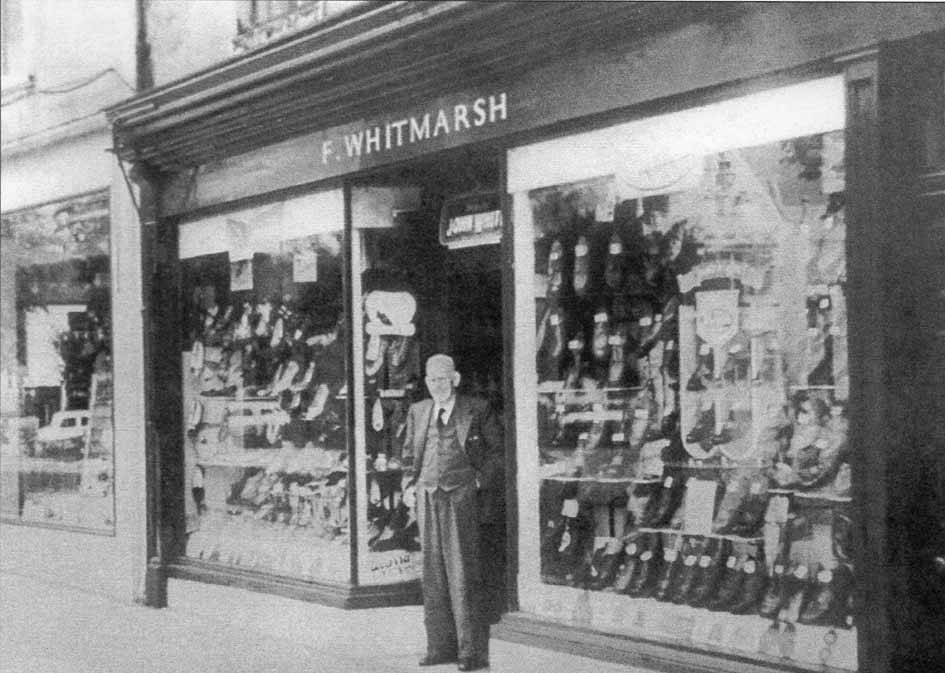 At the end of Church Walk (now the Games Shop) was Knees ironmongery and they displayed their buckets and dustbins etc along the outside of the shop towards the Church gate – very trusting although there were rumours of children taking away the odd bucket.
At the end of Church Walk (now the Games Shop) was Knees ironmongery and they displayed their buckets and dustbins etc along the outside of the shop towards the Church gate – very trusting although there were rumours of children taking away the odd bucket.
Turning the corner from Taylors was Evans – a high class grocers, although it was very close to home the family bought their groceries at Hamatons in Silver Street. Evans was generally patronised by the town’s well–to–do and also sold wine – but only during the licensing hours. Jessie took the family shopping list to Hamatons in Silver Street until it closed, then transferred her allegiance to Sainsburys on the Parade – as that was where the staff were re–employed. The week’s groceries generally came to 30 shillings (£1.50) and were delivered free by a boy on a bike. Milk was delivered from Randalls in Timbrell Street – the churn hanging from the handlebars of the delivery bike.
Unsurprisingly Jessie recalls their family shop in great detail. Behind the shop was the sitting room which was incorporated into the shop. To the right of the shop was a long passage to the back, and one entered the house through a side door to a corridor that passed the stairs and entered the kitchen, beyond which was the living room, and from there one entered the back yard. In the back yard steps led up to a room above the living room, which was where Mr Whitmarsh had his workshop for repairing shoes. Upstairs on the first floor was a sitting room – the only room in the house to have a carpet, 3 bedrooms and a bathroom. It was not often that houses had a bathroom, however washing and bathing were not so easy as today – the only source of hot water was from a coal–fired copper in the shed. It was carried in buckets across the yard to the house, up the stairs and along the corridor to the bathroom. Consequently one did not bathe too often! On the second floor, were 4 more rooms, two of which were used for storage for the shop, and it was in the front room in this floor overlooking the Church that Jessie had her bedroom.
From her bedroom window high up at the top of the house Jessie had a wonderful view of St James Church and churchyard. During the war the railings that topped the church wall were taken away (it would be lovely to see them restored). In 1941 Jessie heard a plane flying low over the town and looked out of her window. It was a German plane firing its guns as it dropped a bomb on the town bridge. Half of the ceiling in Jessie’s bedroom fell and her precious bedroom suite was covered in dust and rubble, she ran down stairs to bemoan the fact – only to be told that as long as she was OK the suite didn’t matter. Later in the morning the family safely shut up the dog and cats, donned their coats and taking their valuables with them (in case the raider returned) they viewed the damage. The first person on the scene had been the rector, The Rev Nisbet-Wallace. For the duration of the war Jessie remembers he conducted lunch time services to pray for peace and as a concession, the notices said “Hats are not required”. Once when Mr Whitmarsh was ill, the Rector asked if he should stop the bells being rung as it may disturb him, but there was no need as he was so used to the bells and the chiming clock he never heard them. At the coronation in June 1953 the whole church was decorated in red, white and blue.
Another scene witnessed from her bedroom was when she saw a herd of cows break into the churchyard on their way to the slaughter house in Back Street (where the car park is now). It took a long time to round them up and as Jessie watched she willed the cows to avoid capture.
Customers would often prop their bicycles against the wall and mothers would park their prams outside too – but Mr Whitmarsh insisted the mothers bring the prams in – he did not agree with the babies being left outside. Every evening, the police patrol went through the town trying the doors of the business premises to check they were securely locked, several times the two on patrol walked into the living room via the shop and commented that the property was not secured. Occasionally Mr Whitmarsh forgot to bring in the wellington boots which were hung from the ceiling in the doorway of the shop. The police would call out, “Your boots are still out” – they were rapidly recovered! At one stage the council decided that Church Walk residents must put their dustbins by the George Hotel to be emptied. Her father rebelled at this, reasoning that some houses had drives as long or longer and if the council enforced it, he would tip the contents of his bin into Church Walk – the council backed down. Mr Whitmarsh worked until he was almost 81. Until he was 70, his only holiday was from Whit Sunday until the following Wednesday, i.e. 3 days a year, during which time the family visited friends in Lancing. At the age of 70 he declared that he would take more holiday and from then until he died took a whole week. At the time of his death Jessie and her father were the only remaining residents of Church Walk, all other shopkeepers having moved from living above the shop. Both Jessie’s mother and father died in hospital but their funerals took place from home and on each occasion the police closed Church Walk to give the family privacy to process to the church.
Church Walk remains a very picturesque part of Trowbridge and it has been fascinating hearing reminiscences of its past.
An Invitation from BOA Preservation Trust Civic Society members (and family and friends) are invited to |
Annual General Meeting – 18th March 2008
Over thirty members of the Society were in attendance at the ACM at Courtfied House. The existing Officers and Executive Committee Members were all re-elected to serve for another year with the very welcome addition of Jonathan Hawkes who has created and maintains the Society’s website.
The accounts were presented and the treasurer reported that the Society’s funds are in a healthy state.
Talk by Trevor Heeks, Trowbridge Town Crier 18th March 2008
Thankfully recovered from his illness of last year, Trevor made a spectacular entrance following the AGM. In full ceremonial dress and ringing his bell he began with a brief history of Trowbridge and of town crying; it began in Greece to advertise battle venues.
Trevor was born into a close knit large family in Shipston on Stour – gamekeeping, fishing and gardening members of the family ensured a healthy diet. 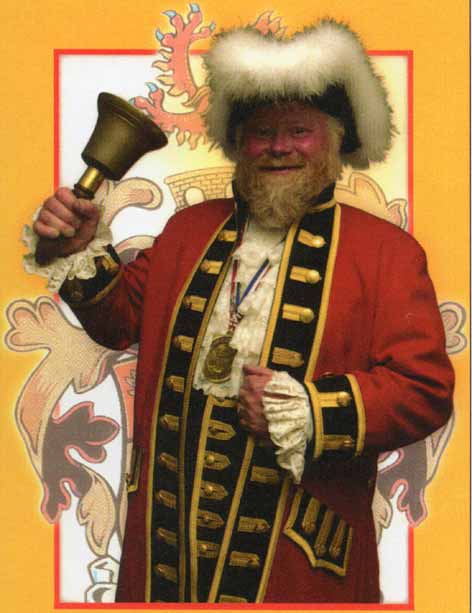 His strict but kindly headmaster gave him the confidence to overcome a stutter and as a very old man he was much moved by Trevor’s early town crying championship successes. The police constable enforced the 8pm children’s curfew, admonishing the parents when necessary, and the town crier sometimes allowed the young boys to ring his bell, but never let them “cry”. Trevor was lucky to survive the installation of electricity – being thrown across the room when he experimented by putting a finger in the socket!
His strict but kindly headmaster gave him the confidence to overcome a stutter and as a very old man he was much moved by Trevor’s early town crying championship successes. The police constable enforced the 8pm children’s curfew, admonishing the parents when necessary, and the town crier sometimes allowed the young boys to ring his bell, but never let them “cry”. Trevor was lucky to survive the installation of electricity – being thrown across the room when he experimented by putting a finger in the socket!
In 1986, Trevor won a tough competition to become our Town Crier and his first appearance was at the carnival. He rode in a new Ford pickup into which coins were thrown but so many hit the paintwork that it cost £500 to restore! Trevor has entered many competitions, starting in 1987 and outside the UK has visited Belgium, Canada and Australia. An emigrant in Canada enquired about the “dust hole” (Kings Arms) and an Australian told him of relatives in Staverton. After winning the European Championship in Belgium, Trevor, with a coach load of other UK contestants, returned bearing significant prizes and gifts including lots of drink. At UK Customs, a (jealous?)Welsh crier told the customs officer he should search Trevor’s luggage. When Trevor explained how he had come by his prizes, the officer closed up the bags, congratulated him and sent him on his way. The coach was delayed however while the Welshman was asked to undergo a strip search. Given a day’s leave from his job at the Cement Works to attend the Town Hall centenary celebrations, Trevor was asked to step in and officiate as the guest of honour was unavoidably detained at the last minute – the plaque nevertheless bears the name Col. Sir Hugh Brassey KCVO OBE. Trevor sang in the choir at the opening service for the restored Coventry Cathedral and “cried” regularly for the late Queen Mother’s birthday. He obviously loves the life of the Town Crier – “be loud and clear” and has always received help and encouragement from his wife. He has already entered 99 competitions, the judges look for clarity, diction and inflection. He was looking forward to his 100th competition later in the month.
Oyez, oyez, oyez.
After the talk delicious refreshments were provided by Ruth Bridges and Daphne Peat organized the raffle.
From the Chairman
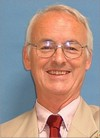 The editors of the ASHTAV News, the magazine of the Association of Small Historic Towns and Villages, have, in the two most recent editions, published details from our two latest newsletters. Could it have been the new format that caught their attention?
The editors of the ASHTAV News, the magazine of the Association of Small Historic Towns and Villages, have, in the two most recent editions, published details from our two latest newsletters. Could it have been the new format that caught their attention?
You will find in the TIC copies of ‘Ancient.Modern’ published by the Visit Wiltshire Partnership. It is unfortunate, to say the least, that Trowbridge is not even mentioned. Bradford-on-Avon on the other hand is mentioned more than 17 times and has 4 photographs. Many of the museums in the county are listed, including those at Wootton Bassett and Purton, but not the Trowbridge Museum. The fact that Trowbridge has one of the finest textile exhibits in the country, and arguably the finest of the five remaining spinning jennies in the world, still was not enough to merit inclusion.
It is good to see a local primary school encouraging their pupils to think about how they would like to see their town developed. Children at Studley Green Primary School have been working on a geography project focusing on potential development sites in Trowbridge. Deputy headteacher Nigel Andrews, said the project takes its inspiration from West Wiltshire District Council’s Transforming Trowbridge website. He asked the children to look at one of the potential development sites and come up with a plan of what they would like to see built there. e said, “The children are as fed up as everyone else about the lack of development so we put our minds to coming up with ideas. Their favourite spot in the whole of Trowbridge is the Town Park, so initially they wanted more parks on the unused land, but they came up with some more complex ideas”. Adam Nardell, West Wiltshire District Council’s regeneration officer said, “Some of them could have futures as architects and property developers. They have a real insight into the process”.
Well done Studley Green!
Our thanks to the Wiltshire Times for permission to use this article and photograph.

New Members
Welcome to the following new members: Mr M J Alford, Miss V Dix, Mr & Mrs P English, Mr & Mrs D Hagger, Mr R Maidment, Mr & Mrs A Milroy and Mr P Smith